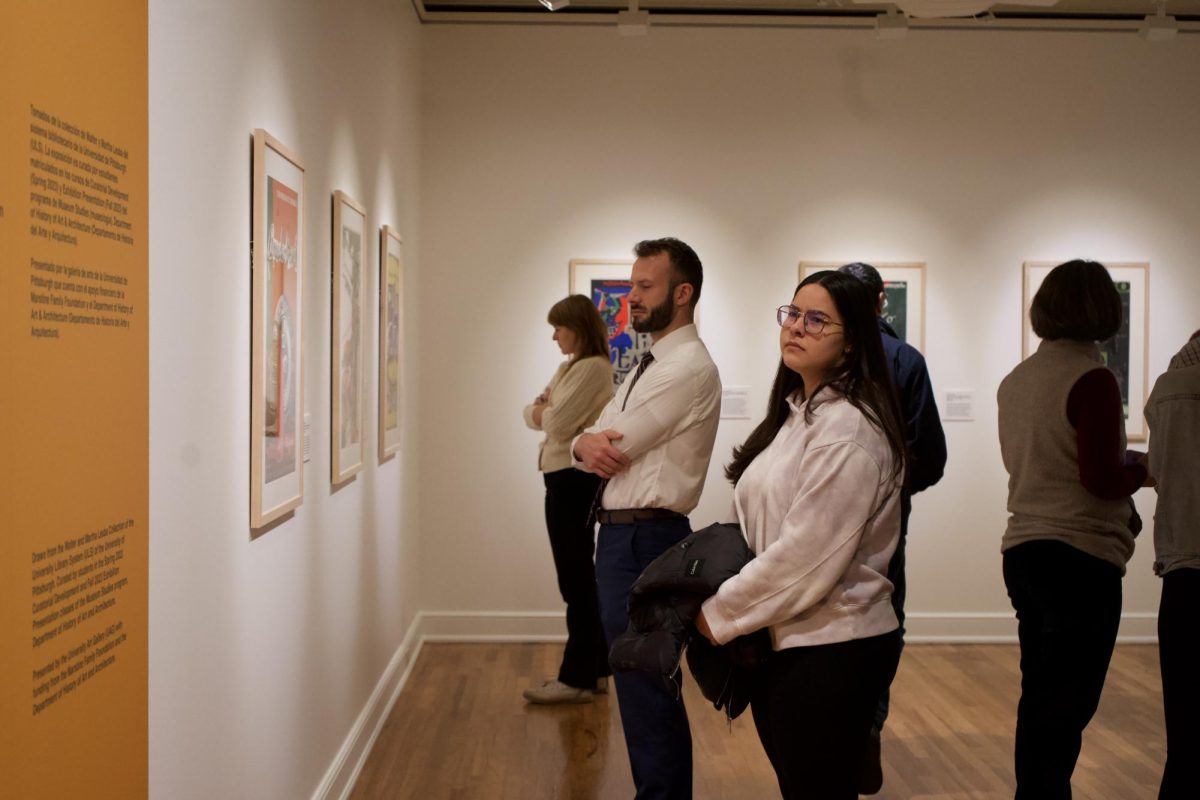Vivid colors and abstract designs bring the history of Puerto Rico to life in the University Art Gallery’s exhibition “Printing Culture: Gráfica de Puerto Rico.” The student-curated exhibit is the culmination of students’ work throughout a two-semester class series centering on curatorial research and development. The posters featured in the gallery tell the history of Puerto Rico’s cultural identity and its push toward independence.
Located in the Frick Fine Arts Building, this exhibition runs until March 2024 and features a variety of opportunities to learn more about Puerto Rican identity and the process of silk screening. Various artists from Puerto Rico created the posters during the 1950s and ‘60s to depict the island’s political and cultural climate. Artists originally created them for mass production, with bright colors and a combination of concrete images and abstract designs to draw attention to the posters’ political messaging.
Sylvia Rohr-Samaniego, director of the University Art Gallery, said this exhibition brings a new and important vision of Caribbean identity and Puerto Rican culture to the University.
“I think that’s important. It’s an overlooked aspect of some studies,” Rohr-Samaniego said. “We’ve never taken that on at the University Art Gallery before, so it’s been really nice.”
Abby Dzwik, a junior anthropology and museum studies major, was heavily involved in the curation of this exhibit. Her experience with the exhibition has helped her develop a deeper understanding of Puerto Rico’s history and culture.
“I just really wanted to dive more into research and uncover Puerto Rican culture from an outsider’s perspective,” Dzwik said. “It’s definitely helped me understand the historical context and how that’s important in building the national identity of Puerto Rico.”
In addition to the historical contexts of the posters in the exhibit, Dzwik said her research also focused on the blend of ethnic groups that created the culture of Puerto Rico.
“What I wanted to put particular emphasis on was that Puerto Rico has a multiethnic approach to its culture because of Taíno indigenous roots, African roots and Spanish roots, and so it’s such a wonderful little mix of cultures,” Dzwik said. “I think it’s so unique, and you can see that uniqueness littered throughout the posters.”
Hot Metal Bridge Fellow Monica Daniels also worked on the exhibit’s curation. She said she enjoyed the immersion of the experience.
“This whole process overall has just been so fun,” Daniels said. “We had to collaborate on everything down to the design, the placement of the posters in the room and the lighting. We got an opportunity to talk and give our opinions about all of these. We also just had a wonderful immersion into the process.”
The students involved in the research and curation of the exhibit also got a look into the process of silk screen printing. Daniels said it gave her a greater appreciation of the effort and skill behind the creation of each design.
“It really does put things into perspective when you think about the skill set that these artists must have had,” Daniels said. “Nowadays as artists, we have so much technology and shortcuts, so it makes you think about what was it like for them to create these beautiful, beautiful posters.”
The well-preserved silk screen posters paint an intricate picture of Puerto Rico’s national identity and culture. Camila Aguayo, another Hot Metal Bridge fellow, said she appreciated that the exhibit gave her culture the recognition it has lacked in the past.
“My favorite aspect was being able to put Puerto Rico in a space where I never imagined it having the opportunity to be,” Aguayo said. “Puerto Rico is usually overlooked in the way we teach, talk and think about the United States’ relationships with its territories. This exhibition allowed us to show people how Puerto Ricans never gave up on who they were.”
Aguayo added that this exhibition was an important way to display the research that students had conducted for months, and how curation can create a sense of community.
“As researchers, we have an abundance of information that is sometimes only kept to ourselves or shared with a few people,” Aguayo said. “With curation, our research can be put at the forefront and shared with communities that might feel identified within it.”
Daniels said she is passionate about how the posters create conversation around the artworks and Puerto Rico as a whole.
“These things should stir up conversations, and I think that’s something I’m passionate and excited about,” Daniels said. “As an art scholar and soon-to-be art historian, you would want your exhibition to leave an impact of dialogue, community and hopeful change.”
Aguayo said she hopes that the exhibit leaves an impact on visitors and helps them appreciate the beauty of Puerto Rican culture.
“I want people to feel and understand the beauty and culture that comes from our island,” Aguayo said. “I want people to walk into the exhibition and feel as if they have moved into a completely transformative space.”


